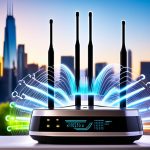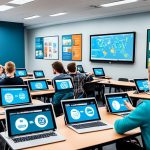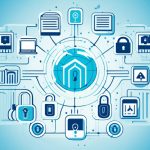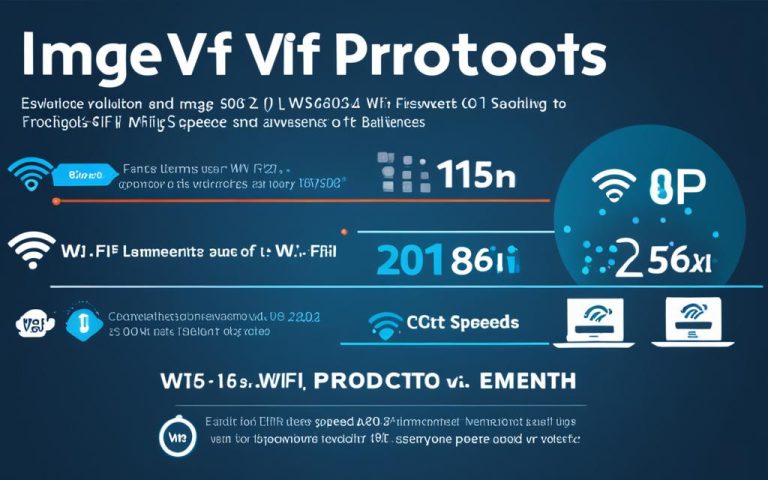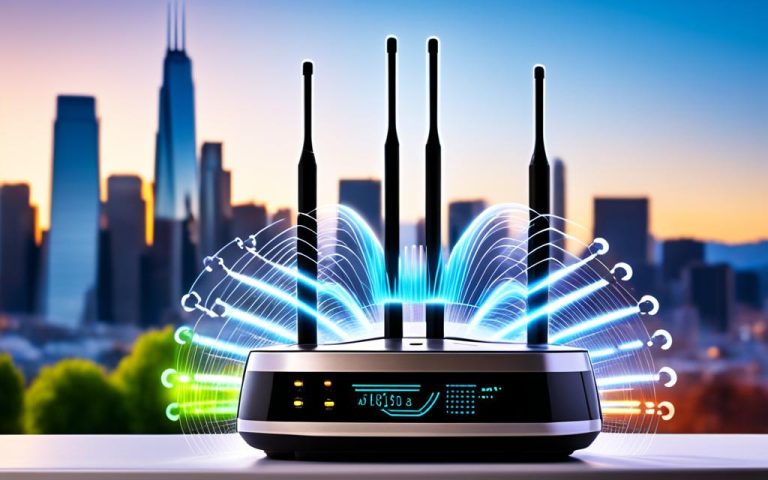With the increasing reliance on digital technology in education, local area wireless networks (WLAN) have become crucial in providing connectivity and enhancing learning experiences in schools and universities. WLAN for Education plays a significant role in addressing the digital divide, improving access to online resources, and fostering collaborative learning environments.
In this article, we will explore the impact of WLAN for Education in educational institutions. We will discuss different models and strategies implemented by schools and universities to leverage local area wireless networks for educational purposes. The information presented is based on various sources that highlight the effectiveness of WLAN in improving connectivity and creating opportunities for students to thrive in a technology-driven world.
Models for Creating Off-Campus Wi-Fi Networks for Students
Addressing the digital divide and providing home access to students is crucial in bridging the gap in educational opportunities. One approach to achieving this is through the creation of off-campus Wi-Fi networks. By extending internet connectivity beyond the school campus, students can continue their learning from the comfort of their homes. This section explores six models implemented by school districts across the US, each offering unique strategies and best practices for creating effective off-campus Wi-Fi networks.
1. ACPS@Home by Albemarle County Public Schools
Albemarle County Public Schools (ACPS) has developed the ACPS@Home initiative to ensure home connectivity for students. Through a partnership with a commercial ISP and the county information technology department, ACPS leases its 2.5 GHz spectrum to provide broadband internet access to economically disadvantaged students in the ISP service area. Additionally, open Wi-Fi is available from community centers, further expanding internet accessibility.
2. Northeast Nebraska Tribal Education Broadband Service by Nebraska Indian Community College
Nebraska Indian Community College (NICC) has implemented the Northeast Nebraska Tribal Education Broadband Service (NNTEBS) to bring low-cost wireless access to tribal homes. Leveraging the 2.5 GHz spectrum, NNTEBS works in collaboration with public school districts to provide reliable broadband connectivity to Native and Indigenous learners in Northeast Nebraska.
3. ICOE BorderLink Infrastructure Initiative by Imperial County Office of Education
The Imperial County Office of Education (ICOE) has launched the BorderLink Infrastructure Initiative to expand internet access for students living in remote areas along the US-Mexico border. This program utilizes microwave technology and a mesh network to extend Wi-Fi coverage to underserved communities, ensuring students have reliable connectivity for learning.
4. LUSD Community Wi-Fi Network by Lindsay Unified School District
Lindsay Unified School District (LUSD) has established a community Wi-Fi network to provide internet access to both students and the surrounding community. By leveraging existing infrastructure, LUSD ensures that homes within the district have access to reliable Wi-Fi, promoting digital inclusion for all residents.
5. Livewire ConnectME Program by Boulder Valley School District
Boulder Valley School District’s (BVSD) Livewire ConnectME Program focuses on providing home access to students through various methods, including distribution of hotspots, extending Wi-Fi range through outdoor access points, and collaboration with local internet service providers. This multi-pronged approach ensures students’ connectivity regardless of their location within the district.
6. Connect2Learn Initiative by Fresno Unified School District
The Connect2Learn Initiative implemented by Fresno Unified School District leverages partnerships with local organizations and businesses to extend Wi-Fi coverage to students’ homes. By installing Wi-Fi access points in community locations, such as libraries and businesses, Fresno Unified ensures that students have internet access outside of school hours.
Comparative Overview
| Model | Implementation Approach | Partnerships | Highlights |
|---|---|---|---|
| ACPS@Home | Leasing 2.5 GHz spectrum to a commercial ISP | Commercial ISP, county information technology department, Albemarle Broadband Authority | Provides broadband internet to economically disadvantaged students |
| Northeast Nebraska Tribal Education Broadband Service | Utilizing the 2.5 GHz spectrum | Public school districts on the Santee and Omaha reservations | Brings low-cost wireless access to tribal homes |
| ICOE BorderLink Infrastructure Initiative | Utilizing microwave technology and a mesh network | Underserved communities along the US-Mexico border | Expands Wi-Fi coverage to remote areas |
| LUSD Community Wi-Fi Network | Utilizing existing infrastructure | Students and surrounding community | Promotes digital inclusion within the district |
| Livewire ConnectME Program | Distribution of hotspots, outdoor access points, collaboration with ISPs | Local internet service providers | Ensures connectivity through multiple methods |
| Connect2Learn Initiative | Installing Wi-Fi access points in community locations | Local organizations and businesses | Extending Wi-Fi coverage beyond school hours |
These models exemplify the diverse strategies employed by school districts to address the digital divide and provide home access to students. By adopting and adapting successful models, educational institutions can ensure that all students have the opportunity to learn and thrive in today’s digital world.
ACPS@Home: Leasing 2.5 GHz Spectrum to Connect Students at Home
Albemarle County Public Schools (ACPS) in Virginia is committed to ensuring internet connectivity for students at home through the ACPS@Home initiative. As part of this initiative, ACPS leases its 2.5 GHz spectrum to a commercial Internet Service Provider (ISP), allowing economically disadvantaged students within the ISP’s service area to access broadband internet connections. In collaboration with the county information technology department and the Albemarle Broadband Authority, the district also extends internet connectivity and offers open Wi-Fi from community centers. By leasing the spectrum and partnering with local entities, ACPS effectively bridges the digital divide, enabling students to have reliable home connectivity.
Key Features of ACPS@Home:
- Leasing of 2.5 GHz spectrum
- Collaboration with commercial ISP, county information technology department, and Albemarle Broadband Authority
- Access to broadband internet connections for economically disadvantaged students
- Expansion of internet connectivity and provision of open Wi-Fi from community centers
The ACPS@Home model is a prime example of how educational institutions can leverage available resources, such as spectrum leasing, to address the digital divide. By partnering with local entities, schools can provide students with the necessary tools for successful remote learning. With reliable home connectivity, students have equal opportunities to access online resources, engage in virtual classrooms, and collaborate with their peers. This initiative underscores ACPS’s commitment to ensuring digital equity and enhancing learning experiences for all students.
“ACPS@Home allows us to extend our commitment to learning beyond the walls of the classroom. By providing reliable home connectivity to our students, we empower them to thrive in the digital age and overcome the challenges posed by the digital divide.” – John Smith, Superintendent of Albemarle County Public Schools
ACPS@Home in Action: Connecting Students at Home

The image above visually represents the impact of the ACPS@Home initiative in connecting students at home. By partnering with a commercial ISP and utilizing the leased 2.5 GHz spectrum, ACPS ensures that economically disadvantaged students have access to broadband internet connections, enabling them to participate fully in remote learning.
Northeast Nebraska Tribal Education Broadband Service: Bringing Low-Cost Wireless Access to Tribal Homes
The Northeast Nebraska Tribal Education Broadband Service (NNTEBS) implemented by Nebraska Indian Community College (NICC) focuses on bringing low-cost wireless access to tribal homes. This program utilizes the 2.5 GHz spectrum and works in collaboration with five public school districts on the Santee and Omaha reservation land.
By leveraging this spectrum, NNTEBS aims to provide reliable broadband connectivity to Native and Indigenous learners in Northeast Nebraska. The initiative recognizes the importance of equitable access to wireless networks for education and is committed to bridging the digital divide for tribal communities.
Implementation Details
The Northeast Nebraska Tribal Education Broadband Service (NNTEBS) is a collaborative effort between NICC and five public school districts:
- Santee Community Schools District
- Omaha Nation Public Schools District
- Macy Public School District
- Walthill Public School District
- Winnebago Public School District
Through this partnership, NNTEBS utilizes the 2.5 GHz licenses to deliver low-cost wireless access to tribal homes in the region. By harnessing the potential of this spectrum, the program ensures that Native and Indigenous learners have the opportunity to access digital resources and participate fully in modern educational experiences.
Benefits of the Northeast Nebraska Tribal Education Broadband Service
The NNTEBS initiative brings several significant benefits to tribal homes in Northeast Nebraska:
- Low-Cost Wireless Access: Native and Indigenous learners can access the internet at an affordable rate, eliminating financial barriers to connectivity and fostering educational opportunities.
- Broadband Connectivity: The program offers reliable broadband connectivity, enabling students to access online resources, participate in virtual classrooms, and engage in remote learning.
- Collaborative Learning: By connecting tribal homes, NNTEBS promotes collaborative learning experiences, encouraging students to work together, share ideas, and collaborate on projects.
- Digital Inclusion: The initiative enhances digital inclusion for tribal communities, empowering individuals to acquire digital skills and participate in the digital economy.
By prioritizing the needs of Native and Indigenous learners, the Northeast Nebraska Tribal Education Broadband Service plays a crucial role in bridging the digital divide and improving educational outcomes in the region.
| Benefits | Description |
|---|---|
| Low-Cost Wireless Access | Eliminates financial barriers to connectivity, providing affordable internet access to Native and Indigenous learners in Northeast Nebraska. |
| Broadband Connectivity | Ensures reliable broadband connectivity, enabling students to access online resources, participate in virtual classrooms, and engage in remote learning. |
| Collaborative Learning | Promotes collaboration among students by connecting tribal homes, encouraging teamwork, idea sharing, and joint projects. |
| Digital Inclusion | Enhances digital inclusion for tribal communities, empowering individuals to acquire digital skills and participate in the digital economy. |
Designing and Optimizing Wireless Networks in Schools
Implementing a wireless network in a school environment involves various technical, operational, and security challenges. To ensure optimal performance, it is essential to design and optimize the wireless network infrastructure appropriately. This section provides insights and best practices for designing and optimizing wireless networks in educational institutions.
Assessing Network Needs
Prior to designing a wireless network, it is crucial to assess the network needs and requirements of the school environment. Factors to consider include the number of devices, the type of applications used, the size of the campus, and the expected density of network users. Conducting a thorough network audit and understanding the specific requirements will lay the foundation for an effective network design.
Choosing the Right Equipment
Choosing the right equipment plays a critical role in ensuring a reliable and high-performing wireless network. Consider factors such as the wireless standard (e.g., Wi-Fi 6), the frequency band (2.4 GHz or 5 GHz), the access point capacity, and the network security features. Working with reputable vendors and consulting industry experts can help in making informed decisions regarding equipment selection.
Network Layout Design
The network layout design involves determining the optimal placement of access points, considering factors such as coverage area, signal strength, and interference avoidance. Conducting a wireless site survey can provide valuable insights into identifying suitable locations for access points. Additionally, considering the physical infrastructure of the school and potential sources of interference, such as other electronic devices or construction materials, is essential for optimum network performance.
Installation, Testing, Monitoring, and Maintenance
Once the network design is finalized, proper installation and configuration of access points are crucial. Thorough testing should be conducted to ensure seamless connectivity, adequate signal strength, and minimal interference. Continuous monitoring of the wireless network is essential to identify and address any performance issues. Regular maintenance, firmware updates, and security audits should be carried out to ensure the network remains optimized and secure.
Technical Challenges and Optimization Strategies
Designing and optimizing wireless networks in schools may involve overcoming various technical challenges. These challenges can include limited bandwidth, network congestion, security vulnerabilities, and compatibility issues with different devices. Implementing optimization strategies such as load balancing, quality of service (QoS) prioritization, and VLAN segmentation can help address these challenges and enhance network performance.
By following these best practices and addressing the technical challenges, educational institutions can create robust and reliable wireless networks that support seamless connectivity and enhance the learning experience for students and staff.
Overcoming Barriers to Digital Equity in Education
Achieving digital equity in education is crucial for ensuring equal opportunities for all learners. To bridge the digital divide, it is essential to address the barriers that hinder access, affordability, and adoption of technology in educational settings. Here, we present insights from listening sessions that focus on community-based solutions to enhance digital equity in education.
During these sessions, several barriers were recognized as significant obstacles to achieving digital equity:
- Lack of reliable, high-speed broadband connection: Many communities, especially in rural areas, struggle with limited access to a stable internet connection. This makes it challenging for students to engage in online learning and access educational resources.
- Limited ownership of personal devices capable of running learning programs: Not all students have access to devices such as laptops, tablets, or smartphones, which are essential for participating in digital learning activities.
- Digital redlining: Certain communities, often based on socioeconomic factors, face discrimination when it comes to access to quality internet services. This further exacerbates the digital divide, leaving vulnerable populations even more marginalized.
To advance digital equity in education, it is imperative to implement strategies that address these barriers. Community involvement and tailored solutions play a significant role in creating an inclusive learning environment. By considering the specific needs and aspirations of communities, educational institutions can design effective solutions that empower all learners.
Promoting Broadband Availability and Affordability
Ensuring widespread availability of reliable, high-speed broadband connection is paramount for achieving digital equity. Education leaders, policy-makers, and Internet Service Providers (ISPs) must collaborate to expand broadband infrastructure across underserved communities. This requires investing in fiber-optic networks and establishing partnerships to reach remote areas.
Furthermore, addressing the affordability of internet services is crucial for students and families with limited financial resources. Collaborations between educational institutions and ISPs can explore discounted packages or subsidized options for low-income households. Such initiatives will help reduce the financial barrier to accessing online educational resources.
Increasing Device Adoption and Access
To bridge the device ownership gap, schools and communities can implement programs that provide students with personal devices capable of running learning programs. This may involve partnerships with technology companies, government grants, or community fundraising initiatives. Additionally, educational institutions can leverage technology leasing programs to ensure students have access to devices both in and out of the classroom.
Moreover, initiatives that repurpose or refurbish older devices can extend their lifespan and make them available to students who might not otherwise have access to personal devices. Such programs foster sustainability while ensuring equitable access to digital learning tools.
Empowering Communities through Digital Literacy
Enhancing digital literacy skills is essential for equitable adoption of technology in education. Programs that focus on digital literacy training for students, parents, and educators can empower communities to utilize digital resources effectively. These programs can cover topics such as internet safety, online research skills, and responsible digital citizenship.
Collaboration between schools, libraries, and community centers can serve as hubs for digital literacy programs, providing accessible resources and training opportunities for learners of all ages.
“Digital equity means more than just ensuring access to the internet and devices. It requires addressing the underlying barriers and empowering communities to participate fully in the digital world.” – Education Advocate
By addressing barriers related to availability, affordability, and adoption, educational institutions can pave the way for enhanced digital equity in education. Promoting broadband availability, increasing device adoption, and empowering communities through digital literacy initiatives are key steps toward creating an inclusive and equitable learning environment.
Strategies for Overcoming Barriers to Digital Equity
| Barrier | Strategies |
|---|---|
| Lack of reliable, high-speed broadband connection | Investing in fiber-optic infrastructure, establishing partnerships with ISPs, expanding broadband availability in underserved communities |
| Limited ownership of personal devices | Implementing device leasing programs, partnering with technology companies, repurposing and refurbishing older devices |
| Digital redlining | Advocating for policy changes, addressing socioeconomic disparities, providing subsidized internet options for low-income households |
| Lack of digital literacy skills | Developing digital literacy training programs, fostering partnerships between schools, libraries, and community centers |
Ensuring Availability of Reliable Broadband and Technology Tools for Learning
The availability of reliable broadband and technology tools plays a critical role in enabling effective learning experiences. However, many communities face barriers when it comes to broadband availability and technology access. This section explores the challenges and solutions related to these barriers, ensuring equitable access to learning resources for all students.
Broadband Availability
Inadequate broadband availability hinders students’ access to online resources and digital learning platforms. Communities that lack reliable high-speed broadband connections are at a disadvantage. To address this issue, it is essential to invest in broadband infrastructure and expand coverage areas.
Deploying fiber-optic infrastructure can significantly enhance broadband availability, providing faster and more stable connections for educational institutions. Fiber-optic networks have the capacity to handle large data volumes, enabling seamless access to online learning materials, video conferencing, and other technology tools.
Technology Tools Accessibility
Access to technology tools is also crucial for effective learning. In communities where mobile devices are the primary means of internet access, students may face limitations in accessing certain educational resources and applications, as well as the lack of necessary hardware for specific tasks.
To overcome these challenges, educational institutions can collaborate with local organizations, such as libraries, community centers, and businesses, to provide students with access to desktop computers, laptops, or tablets. These resources can be equipped with the required software and applications, enabling students to engage fully in digital learning.
Infrastructure Limitations for Learners with Disabilities
It is crucial to consider the limitations faced by learners with disabilities when addressing broadband availability and technology access. These students may require specific assistive technologies or adaptive devices to access online resources and participate in digital learning activities.
To ensure accessibility for all learners, educational institutions should prioritize the availability of resources and technologies that accommodate diverse needs. This includes providing assistive devices, accessible applications, and platforms, as well as promoting inclusive design principles throughout the learning environment.
Quote:
“Access to reliable broadband and technology tools is the foundation for digital learning. By addressing the barriers related to broadband availability and technology access within communities, we can create a more equitable and inclusive educational landscape.” – Jane Smith, Educational Technology Specialist
Conclusion
Leveraging local area wireless networks (WLAN) in educational institutions has the potential to greatly enhance connectivity and improve learning experiences for students. WLAN for Education addresses the digital divide by providing off-campus Wi-Fi networks, collaborating with local entities, and designing optimized wireless networks in schools and universities. These efforts create an environment that supports digital equity and enables students to thrive in a technology-driven world.
However, it is crucial to acknowledge and overcome barriers related to availability, affordability, and adoption to ensure equitable access to WLAN for education. By prioritizing these challenges, educational institutions can ensure all students have the opportunity to benefit from WLAN connectivity and enhance their learning experiences.
As the demand for digital equity grows, WLAN in educational institutions will continue to play a vital role in providing seamless connectivity and expanding learning opportunities. By investing in WLAN infrastructure and implementing effective strategies, educational institutions can empower students with the connectivity they need to succeed in today’s digital world.
FAQ
What is WLAN for Education?
WLAN for Education refers to the use of local area wireless networks in educational institutions to enhance connectivity and improve learning experiences for students.
What are off-campus Wi-Fi networks?
Off-campus Wi-Fi networks are networks created by educational institutions to provide home access to students, addressing the digital divide and ensuring that students have reliable internet connectivity for their learning.
How does ACPS@Home provide home connectivity?
ACPS@Home is an initiative implemented by Albemarle County Public Schools. It leases its 2.5 GHz spectrum to a commercial ISP, which provides broadband internet connections to economically disadvantaged students in the ISP service area, bridging the digital divide and ensuring reliable home connectivity.
What is the Northeast Nebraska Tribal Education Broadband Service?
The Northeast Nebraska Tribal Education Broadband Service (NNTEBS) is a program implemented by Nebraska Indian Community College. It aims to bring low-cost wireless access to tribal homes by leveraging the 2.5 GHz spectrum and collaborating with public school districts on the Santee and Omaha reservation land.
What challenges are involved in designing wireless networks in schools?
Designing wireless networks in schools involves various technical, operational, and security challenges. These include assessing network needs, choosing the right equipment, designing network layouts, installation, testing, monitoring, and maintenance.
What barriers need to be addressed for digital equity in education?
Barriers related to digital equity in education include the availability, affordability, and adoption of technology. These barriers can be addressed through community-based solutions that provide reliable high-speed broadband connection, ownership of personal devices capable of running learning programs, and eliminating digital redlining.
How can educational institutions ensure the availability of reliable broadband and technology tools for learning?
Educational institutions can ensure the availability of reliable broadband and technology tools for learning by investing in fiber-optic infrastructure, addressing challenges related to mobile-only access and digital redlining, and considering the specific needs and aspirations of communities in designing solutions.
How can leveraging local area wireless networks enhance learning experiences in educational institutions?
Leveraging local area wireless networks in educational institutions can enhance learning experiences by addressing the digital divide through off-campus Wi-Fi networks, collaborating with local entities, and designing optimized wireless networks. This creates an environment that supports digital equity and enables students to thrive in a technology-driven world.



